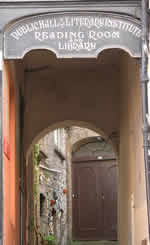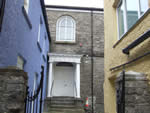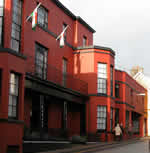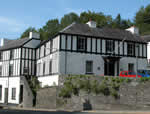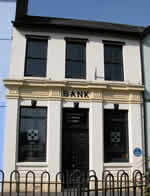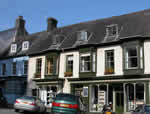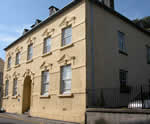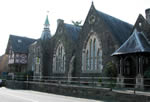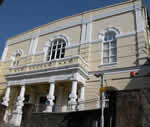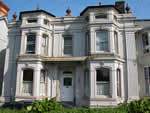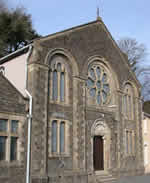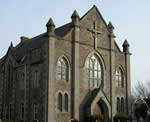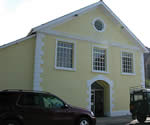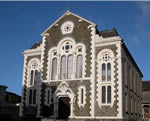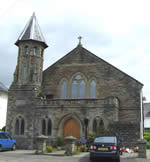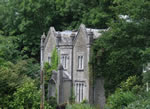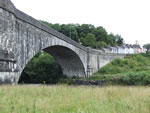Buildings & Architecture
Click on pictures for larger images.
Public Hall and Literary Institute, Rhosmaen Street
In 1892 a former Methodist chapel was remodelled internally as a Literary Institute by A. S. Williams. In 1892 the Chapel authorities had donated the entire building under Trusteeship to the people of Llandeilo as the new permanent home for the Institute. The Literary Institute is currently owned by a charitable trust, though its function as a public reading room and library has ceased.
Llandeilo Public Hall and Literary Institute is located up an alley off Rhosmaen Street, next door to Fountain Fine Art. The building was originally a Calvinistic Methodist Chapel (the oldest in Llandeilo), built in 1788. In 1892 the Chapel authorities sold the freehold to six Trustees to hold in trust for the benefit of over a hundred people of Llandeilo specified in the deed of conveyance. Over the years the building has been used for the benefit of the Community: as a literary institute, library, youth club, for whist drives, old age pensioner activities, Women’s Institute market and currently as a thriving snooker club.
The Llandeilo and District Civic Trust Society has been holding discussions with members of the Executive Committee of the Institute about possible ways of regenerating the building so that it could become available for further use by the community, such as a heritage centre and museum.
Source: Llandeilo Civic Trust
Horeb Wesleyan Chapel, off Rhosmaen Street
Close to the Cawdor Arms, under an arch and at the end of a short passage, is the former Horeb chapel, built in 1810, and enlarged forward in 1849, with an entry up steps under a wooden Doric porch. It discontinued as a Wesleyan Chapel in 1900 with the building of a new chapel in Latimer Road. The old building was used for some years by members of the Tabernacle Chapel in Ffairfach and then used as a warehouse until closure. It was converted into private dwellings in the early 1990s.
The Doric columns, invented by the Dorian Greeks around 700 BC for their pagan temples, look out of place in a Christian church, but were retained as a positive feature during the conversion into private dwellings.
The Cawdor Arms Hotell, Rhosmaen Street
Dominant on Llandeilo’s main street, Rhosmaen Street, is the Cawdor Arms Hotel, renovated in 2005 and repainted a rich dark red. A big three storeys high and five bays wide, the outer ones projecting with two-storey canted bay windows linked across the centre by a balcony over the Doric columned entry. It was formally called the Bear Inn, owned by the Golden Grove estate, and renovated for Lord Cawdor by William Jernegan around 1807. The façade, apart from the bay windows, echoes Jernegan’s hotel at Milford, Pembrokeshire, of 1795; the wide brick chimneys are typically his. The 19th century road realignment through the churchyard brought the angled view into prominence, and the bays with big sash windows, added in the 1840s possibly by Haycock, allowed waiting guests a view of approaching coaches.
The Cawdor Arms Hotel takes its name from the Cawdor family of Golden Grove. The family’s motto is above the door: "BE MINDFUL".
This hotel stands on the site of the old Bear Inn in Rhosmaen Street, and according to a 19th Century observer was very popular: “there above the stables was the Long Room renowned for scenes historical, civil and political – where feasting was carried out and drinking to excess. Here too many a strolling player strutted his hour as a Richard or Alexander.”
In addition to a number of notable thespians of the day like Matthews, Kean and Siddons, etc., who appeared here, the Cawdor Arms was an important meeting place for religious leaders. The first meetings of the town’s Wesleyan Methodists were held here until they built their own church. During the tumultuous period of the Rebecca Riots (1843-1844) troops were billeted here and in other local hostelries for over a year. When Rebecca rioters destroyed Llandeilo’s Walk tollgate on the night of August 9th 1843 the soldiers were fast asleep.
Llandilo (or Llandeilo) Fawr Poor Law Union was formed at a meeting in the Cawdor Hotel on 16th December 1836, and the Llandilo Fawr Union workhouse was erected in 1837-38 at Ffairfach, about half a mile to the south of Llandilo.
St. Teilo's Church
Apart from the medieval tower, the church was rebuilt in the mid-1800s by George Gilbert Scott. See St. Teilo's church page for more details.
The Old King’s Head, Bridge Street
Bridge Street winds up the hill from Llandeilo bridge with a sweep of stuccoed three-bay houses, stepped up the slope. At the top is the Old King’s Head, a plain early 19th century building but of older origin, its small front court a welcome staging post for those struggling up with heavy loads. Inside is a carved stone fireplace of the 1730s with central shell and scrolled foliage, salvaged from Llwynybrain, Llandovery. As its name implies it was formally a public house but today houses the South-west Wales headquarters of the National Trust.
The Old Bank
In the 18th and 19th centuries livestock droving was an important part of the Welsh economy. Drovers took cattle, sheep and other livestock from west Wales to the large English cities, whose rapidly expanding populations had to be fed. London was the largest consumer of food and west Wales drovers would collect cattle all along their journey so that they would arrive at the capital city with vast herds for sale at London 's Smithfield market.
These drovers were not only entrusted with the cattle of local farmers but also with the money from their sale when they returned. Droving was a respected occupation, as drovers also carried rents from Welsh estates to the absentee landlords living in London . As these drovers carried large amounts of money with them it made sense to open a bank along the drovers' route where money could be safely deposited.
Llandovery stood at the junction of three droving routes from Pembrokeshire, Carmarthenshire and Cardiganshire to London . David Jones, a drover, set up the Black Ox Bank in 1799. This issued its own bank notes and was incorporated into Lloyds Bank in 1909. The first bank in Llandeilo was opened on the 15th April 1842 and rebuilt in 1887. Number 1 Bank Terrace is the former David Jones and Co. bank, 1887, designed by J. Calder of London . Plain but substantial three bays with emphatically iron-bound doors. The former Nag's Head to the left was owned by the bank and re-modelled in 1887 "to be convenient for those waiting to do business", a reminder that the David Jones bank was founded in a Llandovery Inn. The Interior retains an exceptionally well preserved banking hall and vaults probably dating form 1887.
No. 5 King Street
Facing the churchyard, mostly converted houses in the 19th century, is King Street. King Street was named to commemorate a short visit by George IV in the 1820s (George Street and George Hill also commemorate this special day). King Street slopes down along the North side of the churchyard, the triangular space being the former market square. No. 5 was a good six-bay town house of the 1730s, known from early photographs, altered with the contemporary three-bay No. 6 in the late 19th century. The roof-pitch and narrow windows show the original date. No. 4 has delicate and unusual slightly Italianate stucco detail of around 1860, square bays flanking a matching porch, all with balconies.
Abbeyfield House, George Street
In George Street, on the right, are Maesgwynne and Morfa, bright yellow and red brick with red tiles and timbered gables, by David Jenkins, around 1897, and the bulk of Abbeyfield House, which was once the George Hotel, then the vicarage until 1905 and converted into a home for the elderly, 1991–4, by Alwyn Jones of Penlan Design Practice. In 1839 a Mechanics’ Institute was first held in the town, whose students met in the Long Room of the former George Hotel.
The tall paired stone chimneys suggest that Edward Haycock may have done the vicarage conversion around 1840, when an upper storey was apparently removed. (Edward Haycock was the architect who finally completed the construction of Llandeilo stone bridge, 1843-1848, after the original architect William Williams and his builder Morgan Morgan had failed). The five-bay former façade, to George Hill, is heavily stuccoed, around 1905, clearly by Jenkins. George Hill runs into King Street past the Davies Memorial Hall, 1874, a Gothic intrusion among simple rendered fronts.
Former National School, Carmarthen Street
Before local councils took over the running of schools around 1870 church and, occasionally, chapel authorities were given responsibility for running primary school education. The National Society (Church of England) for Promoting Religious Education created a network of over 5,000 schools which became known as National Schools. When it was founded in 1811, the National Society's aim was that "the National Religion should be made the foundation of National Education: education for all, firmly based on the Christian Gospel and Anglican principles". With prodigious energy, the Society established a national system of education, supplemented by the State from 1870 onwards. The non-conformist chapels had a smilar, though much smaller, network of schools run by the British and Foreign Schools Society, known as British schools.
Facing the very regular square-shaped Provisions Market on Carmarthen Street is the wildly irregular former National School, built in 1860 by W.M. Teulon, for Lord Dynevor. Teulon, younger brother to the rogue Gothic architect S. S. Teulon, was selected as early as 1854, over Dynevor’s usual architect, Richard Kirk Penson, for reasons unknown. It was Richard Kyrke Penson who had completely rebuilt Lord Dynevor’s stately mansion of Newton House in Dinefwr Park. The National School is in brown stone with Bath dressings, in an acid and angular Gothic. Single storey, four bays, with big twin centre gables over four-light lancets with two-tone voussoirs, and blind cinquefoils above, flanked on one side by a smaller gable with a big hipped timber porch, and on the other by a most odd tower: cross-gabled and gargoyled, the gable tops are cut off for a slated spire with open bell-lantern. Contemporaries were surprised at the use of iron uprights between the two long classrooms. To the left, is the Master’s House, formerly the Charity School of around 1800, renovated in the mid 1850s for Lord Dynevor by R. K Penson, with a great timber-framed storeyed porch, more appropriate to Ludlow.
The Provisions Market, Carmarthen Street
The provision market was built [on Carmarthen Street in 1838] at the expense of A. J. Gulston Esq. of Derwydd. It served a wide area, particularly after railway development began. Previously, an open market had been held in Market Street. It extended to the back of Waterloo House. Butter and farm produce generally were sold there. Fish stalls were under the chestnut tree on the Church Square. Across the road were the shambles where cattle were slaughtered. Welsh flannel was sold at stalls in King Street. Corn and cheese were sold on the ground floor of the Shire Hall. The corn of the Towy Valley was renowned. Sir William Paxton, a shrewd financier, realised its worth. Early in the 19th century, he had plans for developing Milford Haven as a port. He intended to export from there to America, abundant supplies of corn from the Towy Valley.
The Shire Hall, Carmarthen Street
Now Cambria Archaeology. Hardly sited to impress, in this steep narrow street, the Shire Hall was built in 1802 by Thomas Humphreys of Carmarthen, as a hall for Quarter Sessions over an open market. A more elaborate design by William Jernegan was abandoned when the committee offended the architect. Successive county surveyors made changes through the 19th century and nothing is discernible of the original save two iron columns inside. In 1901, David Jenkins remodelled the front heavily but without panache. Rusticated ground floor with arched windows, a porch with blocked columns and balcony, and part-fluted Ionic pilasters above, under a shallow gable.
In the early 20th century, the Shire Hall became the headquarters of the Carmarthenshire County Constabulary. Earlier, the head-quarters had been in a block of houses in Church Street, near Canton. The Court Room was on the first floor of the Shire Hall; previously it had been at the back of Manchester House (present day Smithfield). The local Rifle Volunteers drilled in the Shire Hall. Now the headquarters of Cambria Archaeology.
No. 2 Abbey Terrace
Overlooking the East side of St Teilo’s churchyard is Abbey Terrace, a well-designed terrace of four, dated 1840, the outer pair projected with twin shallow bows and overhanging hipped roofs and the centre pair plain with reeded architraves and arched fanlights. The left end house, Abbots Hill, was altered as aggressively as possible around 1900 to display the talents of its owner, the architect, David Jenkins; the added parapet topped with squat red Ruabon terracotta urns. Jenkins died in 1907 and is buried almost opposite under the white marble spired memorial. Beyond the terrace is a length of high castellated garden wall divided by thin piers, the end bays with blind ogee panels Abbey Terrace, with King Street, Church Street and Bank Terrace, were part of the old road system around the churchyard.
Ebeneser Baptist Chapel, Crescent Road
Built in 1829, and rebuilt in 1877 by George Morgan. An economical North Italian Romanesque building. Three giant arches, a big centre wheel window, and simple traceried side windows. The interior is a three-sided gallery and heavily beamed roof. A schoolroom was added in 1899, by G. Morgan & Son.
Capel Newydd (Independent), Crescent Road
Built 1901–2, by Henry Herbert. Large and minimally Gothic, like Gwynfryn chapel in Ammanford. Sandstone and ashlar, including the tall shafts with stumpy pinnacles. The interior is a three-sided gallery with elaborately panelled front, stepped down to the rear organ gallery, the organ set in a tall pointed recess. Its foundation stone was laid 1901 and the first meeting was held in 1902.
Victoria Jubilee Civic Hall, Crescent Road
Built in 1887 to commemorate the Golden Jubilee of Queen Victoria it was used for many years as a Territorial Army Drill Hall. In the 1970s it was taken over by the local council and used as a multi-purpose civic and community hall. The Trustees of Llandeilo Civic Hall, who took over its running from Carmarthenshire County Council in April 2005, have been working very hard to implement new measures to make this a viable and working hall for the Community. Equipped with a kitchen it is now used for events ranging from classical and popular music concerts to dance classes. It includes an arts gallery.
Salem Calvinistic Methodist Chapel, New Road
Built in 1873, by Richard Owens of Liverpool. Brown stone with painted ashlar. Strongly composed winged façade, a relatively early example of this later 19th century form, with Owens’s mix of round-arched Italianate and plate-traceried Gothic (compare Tabernacle, Aberystwyth). Big traceried roundels in the main window heads, and a colander version in the gable. Less intense interior: the galleries with long panels divided by fluted pilasters, the pulpit with arched column-shafted panels, and a flat plaster ceiling with roses.
The original Calvinistic Methodist Chapel had been built in 1788 on Rhosmaen Street and was utilised until the present chapel was built in New Road in 1873. The former building was then adapted to accommodate the Intermediate (ie Secondary) School. Later, in 1892, it became the Public Institute and Library.
Wesleyan Methodist Chapel, Latimer Road
Built by J. W Jones of Llandeilo in 1900. Now divided into houses. Conventional Gothic in stone but an entertaining octagonal tower with a candle snuffer roof to one side.
Moreb, Bridge Street
The large twin-gabled stone house on the Llandeilo side of the bridge, to its left and overlooking the river, is Moreb, built for Lord Cawdor’s Golden Grove agent around 1813, by J. P Pritchett of York (Pritchett’s father was chaplain to Cawdor). The house is built in very early revived Tudor style, with mullioned windows and some hoodmoulds. The lane running past it leads to Llandyfeisant church and into Dinefwr Park.
Llandeilo Bridge, 1843–8
Designed by William Williams, the county bridge surveyor. An extremely ambitious single arch, the third largest in Britain at the time, after the Grosvenor Bridge at Chester and the Westgate Bridge, Gloucester, with a span of 145 ft (44 metres). It still remains the largest single-arch stone bridge in Wales. There are longer single-arched bridges in Wales but they are metal bridges and the only longer stone bridges are all multi-arched.
Massive and unadorned, with grey lime stone dressings, the bridge is supported between buttress-like giant piers. The low medieval bridge of seven pointed arches partially collapsed in 1795. A new three-arch bridge followed, possibly by John Nash, but parsimony allowed only a narrow structure, too narrow for carts to pass. Williams’s bridge was designed to go much higher, to ease the pull up Bridge Street, but the project was well beyond his competence and that of his experienced bridge builder, Morgan Morgan. The entire budget of £6,000 was spent in sinking the foundations in unexpectedly soft ground. Morgan was sacked, Williams died, and Edward Haycock took charge in 1846. The eventual cost of what the county had nick-named the Bridge of Sighs was £23,000.
Sources
Unless stated otherwise the following two books have been consulted as sources:
- Pevsner Buildings of Wales (Carmarthenshire and Ceredigion), Thomas Lloyd, Julian Orbach and Robert Scourfield. Yale University Press, 2006. (Entry for Llandeilo).
- Llandeilo Town Guide, Llandeilofawr Town Council, 1994.
